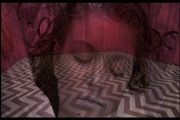 |
Twin Peaks
Fire Walk With Me
Movie
Screenplay by David Lynch and Robert Engels
Directed by David Lynch
Released August 28, 1992 (U.S.) |
A year earlier, FBI Agent Chet
Desmond investigates the murder of Teresa Banks which leads to a
chain of events involving Agent Cooper and the last days of
Laura Palmer.
Read the
film summary at the Twin Peaks Wikia
Didja Know?
Fire Walk With Me is a Twin Peaks film
by David Lynch that was released about a year after the TV series
ended. The story is mostly a prequel to the series, telling of,
first, the investigation into the murder of Teresa Banks in Deer
Meadow, Washington in 1988, then of the last week of Laura Palmer's
life in Twin Peaks one year later. There is a brief element of the
film that could be considered a follow-up to the final episode of
the TV series,
Episode 29:
"Beyond Life and Death". The deleted scenes from the film,
Missing Pieces, also feature some follow-ups to that
episode.
Many critics, and even Twin Peaks fans, did not respond
favorably to the film upon its premiere, mostly due to its dark,
disturbing tone throughout, with almost none of the quirky humor and
characters with which the TV series balanced its darker elements.
The Deer Meadow scenes at the beginning of the film, featuring the Teresa Banks
murder investigation do have light,
quirky moments, but once we head into Twin Peaks, Laura's dark story
leaves little room for them. The deleted scenes feature many of the
quirkier characters and humor, but it was probably wise to cut them,
as they would have interfered with the telling of the main story.
Some fans revised their opinions of the film in the following
years, forgiving its lack of the warmness of the TV series and
acknowledging it as the masterpiece it is when viewed in its own
light. This includes myself, having been sorely disappointed with
the film when I saw it on opening night in 1992; being a Peaks
freak, however, I bought it when it was released on laser disc
anyway, and found myself putting the pieces of the mystery together
until after a couple additional viewings, it became one of my
favorite films of all time.
Actor Kyle McLachlan initially did not want to reprise his role as
Agent Cooper for the film. The script was then rewritten so that
McLachlan would not have to spend so much time shooting, putting the
majority of the Teresa Banks investigation on Agent Chet Desmond
(Chris Isaak) instead, leaving Cooper with just a couple of scenes
at FBI headquarters and the red room scenes. (Note that Chester
Desmond's initials C.D. are the opposite of Dale Cooper's!)
Actress Lara Flynn Boyle chose not to return at all as her character
Donna Hayward. The role was recast with Moira Kelly playing the
part.
Mrs. Tremond's grandson, Pierre, is played by Jonathan J. Leppell
here. In the character's TV series appearances, he was played by
David Lynch's son, Austin.
Most of the film covers the last week of Laura Palmer's life, beginning on
Thursday, February 16 and ending with her death on Thursday,
February 23 (1989). But it seems that one of those days is missing
from the film, as just three days are depicted from Sunday to Thursday. I'm not sure which day of the week is the missing one, but
it must be the day that Laura had her second dream about Cooper (the
one seen from Cooper's viewpoint in
Episode 2:
"Zen, or the Skill to Catch a Killer")
since it is not mentioned or seen in the film. The fan magazine
Wrapped in Plastic #1 speculates the missing day is Tuesday.
Characters appearing or mentioned in this film
Leland Palmer
Teresa Banks
Gordon Cole
FBI secretary (Diane?)
Agent Chester Desmond
Agent Gene (last name unrevealed)
Agent Sam Stanley
Lil
Deputy Cliff Howard
Secretary at Deer Meadow sheriff's station (unnamed)
Sheriff Cable
Jack (associated with Hap's Diner)
Irene
Carl Rodd
Millie (resident of Fat Trout Trailer Park)
Curious woman (at Teresa's trailer in Fat Trout Trailer Park)
Old woman (resident at Fat Trout Trailer Park)
Agent Dale Cooper
Agent Phillip Jeffries
Agent Albert Rosenfield
Judy (mentioned only)
Jumping man
Man From Another Place
BOB
Woodsman
Mrs. Tremond/Chalfont
Pierre Tremond/Chalfont
Diane (mentioned only)
Laura Palmer
Donna Hayward
Mike Nelson
Bobby Briggs
James Hurley
Sarah Palmer
Harold Smith
Shelly Johnson
Norma Jennings
Heidi
Annie Blackburn
Caroline Earle (mentioned only, Annie wears her dress in Laura's dream)
Leo Johnson
Jacques Renault
Log Lady
Buck
Tommy
Ronette Pulaski
One-Armed Man
Mike
The Angel
Didja Notice?
The film opens during the murder of Teresa Banks on February
9, 1988 (as the murder is stated to have occurred in
Episode 8A:
"May the Giant Be With You", though
The Autobiography of F.B.I. Special Agent Dale
Cooper gives the date of her murder as
occurring in January of 1988; the Teresa Banks investigation
portrayed here is also quite different from that in the Cooper
autobiography, chiefly in that Agent Chester Desmond is the
primary investigator with Cooper not involved except very
peripherally in Philadelphia).
The opening shot of the film is of a snowy screen of a
television set suddenly chopped into sparks and parts by an
axe during the murder of Teresa Banks. The smashing of the TV
set may be symbolically saying that this film is not going
to be the same as the TV series...this film is rated R for a
reason, after all.
FBI Regional Bureau Chief Gordon Cole asks his secretary to
get him Special
Agent Chester Desmond when learning of the Teresa Banks
murder in Deer Meadow, WA. Is there any particular reason he
assigns Desmond to the case? Is Desmond the most experienced
in the so-called Blue Rose cases? Is it for his particular
modus operandi? Does Gordon prefer him over Agent
Cooper?
| Who is the secretary Gordon speaks to? Could
it be the elusive Diane? I would imagine Diane acts as
secretary to more than just Cooper. A different
secretary brings Gordon coffee a minute later. Either or
neither could be Diane. |
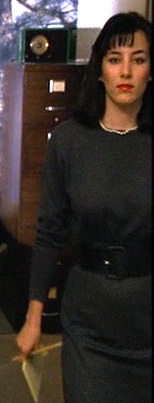 |
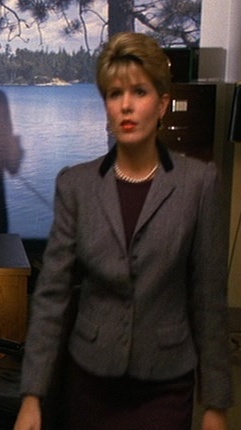 |
Agent Desmond receives Gordon's call while wrapping up a
case in
Fargo,
North Dakota. In the scene, Desmond and two other agents are
arresting two young women and a man next to a school bus
full of screaming, frightened children. It's not explained
within the film, but the script implies the bus driver was
using the school bus to transport prostitutes around town
while also driving the local children to and from school.
The license plate on the school bus is a proper North Dakota
plate of the time.
Notice that when Agent Desmond's car phone rings, the horn
also goes off, to let him know the phone is ringing inside.
Agent Desmond's car in Fargo is a 1978
Ford
Fairmont. In Deer Meadow, he is driving a 1982
Plymouth Gran
Fury; it seems likely this car is an actual FBI vehicle, as
it has twin-mounted spotlights on the hood, just ahead of
the driver's and passenger's doors (although the car phone
in the Fairmont also leans it towards being an FBI vehicle
and not just a rental or personal car).
Notice that Desmond lowers the power antenna on the car
while talking to Gordon on the phone, seemingly in an
attempt to dull the volume of Gordon's voice! Doesn't the
phone have volume control?
The plane Agent Desmond arrives in in
Portland, Oregon is a
Ryan Navion
A model.
The plane sitting behind Gordon and Sam as they wait for
Desmond is a
Cessna
150.
Gordon introduces Desmond to Agent Sam Stanley, saying Sam
has joined them from
Spokane. This implies that Sam is stationed in Spokane.
The plane Lil is standing next to as Gordon "introduces" her
is a Piper PA-18 Super Cub.
The code of Lil's movements, expressions, clothing, etc. is
probably Gordon's way of passing information that won't be
understood by others (due to his loud voice, which is easily
overheard). Possibly, Lil's bizarre presence and Desmond's
explanation of the codes she presents to Sam later on may be a hint to the
film viewer by Lynch that one must pay attention to other
codes and clues throughout the film.
|
Lil was wearing a blue rose pinned to her dress. After
explaining all the rest of Lil's coded message to Sam,
Desmond says of the blue rose, "...I can't tell you about
that." Later, Cooper remarks that the Teresa Banks murder
investigation was "one of Cole's Blue Rose cases." So, what
is the significance of the blue rose as a symbol? A rose of
a blue color is one that is not found in nature due to
certain genetic elements of the genus Rosa. White
roses have been dyed blue throughout the history of human
civilization and portrayed as symbols of love and prosperity
or even royalty. In art and literature, the blue rose often
symbolizes a quest for the unattainable, the impossible, or
a mystery; these appellations may apply to Gordon's Blue Rose
cases as well. Also, a rose in general has been used as a
symbol of secrecy historically.
25 years later, when Season Three of the series was
finally made, Albert tells the story of the origin of the
Blue Rose cases in 1975 and a dying woman who muttered "I'm
like the blue rose," before dying and vanishing in front of
Agents Cole and Jeffries, all suggesting the Blue Rose cases
are those involving a person's double, or tulpa
(see Part 14:
"We Are Like the Dreamer").
Some possible inspirations for the use of the term
"blue rose" by David Lynch are:
|
| |
|
|
Rudyard
Kipling's poem "Blue Roses":
Roses red and roses white
Plucked I for my love's delight.
She would none of all my posies--
Bade me gather her blue roses.
Half the world I wandered through,
Seeking where such flowers grew;
Half the world unto my quest
Answered me with laugh and jest.
Home I came at wintertide,
But my silly love had died,
Seeking with her latest breath
Roses from the arms of Death.
It may be beyond the grave
She shall find what she would have.
Mine was but an idle quest--
Roses white and red are best.
|
The 1944 Tennessee Williams memory
play The Glass Menagerie, in which a young woman
(named Laura!) who is afflicted with pleurosis, a
respiratory disorder, whispers the disease's name to her old
school crush, and he mishears it as "blue roses".
An interesting side-note is that the play opens with the
narrator, Laura's brother, Tom, introducing the scenario to
the audience and cautioning that because the play is based
on his memory, what they see may not be precisely what
happened. Might this have been an influence on Lynch when he
wrote a line of dialog in his 1997 film Lost Highway
for the character Fred Madison, "I like to remember things
my own way[...]not necessarily the way they happened."
Another interesting note is that Piper Laurie (Catherine
Martell on Twin Peaks) told interviewer Scott Ryan
in a Q&A in issue #7 of The Blue Rose magazine that
she played Laura in a (1965) production of The Glass
Menagerie! (The Blue Rose is a Twin Peaks
fan magazine of review and commentary, similar to the old
Wrapped in Plastic; in fact, one of the managing
editors is John Thorne, co-editor of Wrapped in Plastic.
You can subscribe to The Blue Rose at
www.bluerosemag.com). |
Notice that the blue rose pinned to Lil's dress appears to
be plastic.
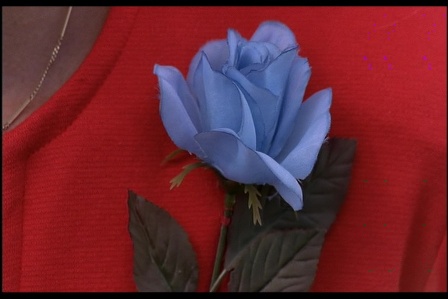
| Notice that the town of Deer Meadow seems to be almost
the opposite of Twin Peaks in many ways: |
| |
- In
The
Autobiography of F.B.I. Special Agent Dale Cooper
and
Episode 0B:
"Northwest Passage", Deer Meadow is said
to be in the southwest corner of Washington; Twin Peaks is
in the northeast corner according to
Twin Peaks: An Access Guide to the Town,
placing them in opposing corners. (However, this film
and
The
Secret History of Twin Peaks imply the two town are much
closer together.)
- The names of the towns have almost opposing nouns in
them, "peak" is a high point in a mountain range,
"meadow" is a flatland of grass.
- The sheriff's station in Deer Meadow is resentful of
FBI presence, the sheriff and deputy are mean, and the
secretary is bitchy...unlike their counterparts in Twin
Peaks.
- The painting hanging in the lobby of the Deer Meadow
sheriff's station is of a buck; the painting hanging in
the lobby of the Twin Peaks sheriff's station is of a
tall tree.
- Hap's Diner in Deer Meadow is run-down and run by
a caustic elderly woman with stained teeth (Irene), whereas
the RR Diner in Twin Peaks is classy and run by the
attractive and helpful Norma.
|
Sheriff Cable refers to Agent Desmond as a "J. Edgar". This is a
slang term sometimes used for an FBI agent. It refers to J.
Edgar Hoover, the director of the FBI from 1935-1972.
At 13:23 on the Blu-ray, Desmond looks at a framed newspaper
clipping on Sheriff Cable's wall with the headline "Cable
Bends Steel". Only the headline and photo accompanying the
article are visible to us, but the actual prop article is
viewable at the
Twin Peaks Props website; the article is mostly just
words arranged into nonsense.
The clock seen in the Deer Meadow morgue at 14:04 on the
Blu-ray is a
General Electric. The scale seen in the morgue is a
Chatillon.
Why does Hap's Diner have a neon sign of a crying clown as
it's logo outside? Seems like a less than optimistic way of
advertising a restaurant!
At 17:18 on the Blu-ray, notice that Jack's name badge at
Hap's Diner is imprinted with "Say Hello to Jack", but the
"hello" is crossed out and, written above it, is "goodbye".
At Hap's Diner, Jack tells Desmond and
Sam about Irene, who works behind the counter, and that "her
name is Irene and it is night. Don't take it any further
than that. There's nothin' good about it." He is likely
referring to the 1908 American folk song "Goodnight, Irene"
and the fact that the Irene who works there presumably does not
appreciate wisecracks about her name in relation to the
song. Notice that Desmond smirks as if he gets the reference, but Sam
seems slightly confused. It is interesting to note, the song includes references to suicide and the verse
"I'll see you in my dreams".
At 17:37 on the Blu-ray, a man is working on fixing a lamp
at Hap's Diner. The strobing light effect as he tries to fix
it may be an indication that BOB or another spirit of the
Black Lodge is near, interfering with the electricity.
At 18:05 on the Blu-ray, notice that there is a log with a
couple of chainsaws stuck in it behind Irene at the counter.
I guess it's a decoration!
A seemingly confused older man in Hap's Diner asks Agent
Desmond if he's talking about "that little girl that got
murdered" and goes on to tell him, "I know shit from
shinola." The colloquialism "shit from shinola" derives from
a reference to the shoe polish company Shinola which existed
from 1903-1960.
A woman speaking French is sitting with the confused older
man. She says, "La nuit est le bon moment." This is
French for "Nightime is the right time."
At 21:21 on the Blu-ray, a note written in marker directly
on the mobile home door of Carl Rodd, the manager of Fat Trout
Trailer Park, reads "DO NOT EVER
DISTURB BEFORE 9 A.M......EVER".
Several notes pinned to his door appear to be addressed to "Rod" rather than "Rodd" or "Carl". One of these notes
appears to read, "My cat is gone, Millie." Other notes read:
"My fridge does not stay cold" with an unreadable signature;
"I'm moving out, Sam."; "My trailer has a leak. Fix it by
tomorrow."
|
At 23:08 on the Blu-ray, the photo of Teresa Banks which Desmond
is looking at has somewhat of the appearance of her having
one green eye (right) and one blue (left). A difference in
coloring between the eyes is known as heterochromia. It is interesting
to note that Agent Phillip Jeffries also has two different
colored eyes (due to actor David Bowie having been injured
in his left eye as a teen). Is there a significance in the
two characters having different colored eyes? Is it a sign
of contact with the Black Lodge? Her eyes seem to both be
the same color in the earlier morgue scene, but it's hard to
say. Here, Desmond is looking closely at the photo, and the
camera pauses on the eyes, so it's possible he noticed the
eye colors too. Some Indian legends say that people born
with different colored eyes are able to see into heaven and
Earth at the same time. Another myth says that such people
can see both angels and demons.
Later, notice that when the Man From Another Place
holds up the ring in Laura's memory of the dream, it is
obscuring his right eye, almost as if the round, green
centerpiece of the ring is standing in for his iris. And
then, Laura remembers that she saw Teresa wearing the same
ring and, in her flashback memory, Teresa's hand moves
across her face such that the ring passes directly over her
right eye; it's hard to tell if her eye changes color after
the ring passes over it or not.
In
Episode 20:
"Checkmate", the
corpse left behind in Sheriff Truman's office by Windom
Earle had one green eye (the left) and one clouded-over eye.
During Phillip Jeffries' recollection of the room
above the "convenience store", recall that the Man From
Another Place talks of the Formica table, saying, "Green is
its color." Is there any connection to the green eyes and
green centerpiece in the ring?
|
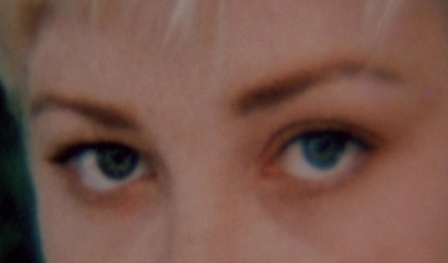 |
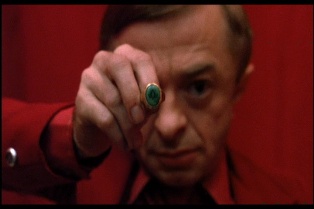 |
| |
|
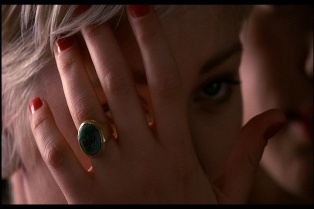 |
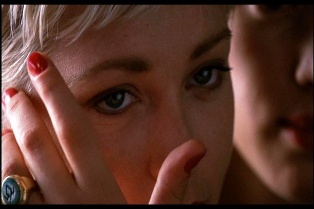 |
At 23:13 on the Blu-ray, the car behind Carl as he brings
coffee from his trailer to Desmond and Sam is a 1972
Dodge
Charger. Is it Carl's car?
Why is Carl wearing a robe? He appears to be fully clothed
underneath, in flannel shirt and jeans! I suppose he's just
wearing it for warmth.
The old woman who appears outside the door of Teresa's
trailer at 24:04 on the Blu-ray looks like David Lynch in
disguise and many fans think it is. The role is credited to
Ingrid Brucato, who seems to be a real person, according to
a brief interview (with photos) with her on
Glastonberry.com.
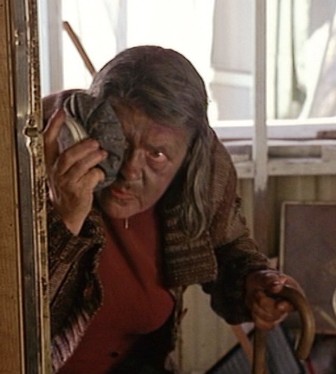
Who is the old woman who appears outside the door of
Teresa's trailer? Why does she hold an ice pack to her head?
How was she injured? It seems throughout this moment and
shortly after that something is happening: we hear
the whooping sound that the Man From Another Place later
makes for Cooper; we see electrical lines running to and
from a pole; Carl looks frightened/nervous, saying "I've
already gone places. I just want to stay where I am.";
Desmond has a look on his face as if he senses something. What
places has Carl gone to? The Black Lodge in his dreams?
The FBI morgue truck seen at 25:47 on the Blu-ray is a 1991
Ford Econoline E-350.
Desmond returns to the Fat Trout trailer park, apparently
inquiring with Carl about Deputy Cliff Howard's trailer
there. Odd that his trailer should happen to be at the same
park as Teresa's. This may suggest that he knew her and had
sold her drugs, which may be why Howard and Sheriff Cable
have been so uncooperative and even resistant to the FBI
investigation, trying to cover up the involvement of local
law enforcement in the drug trade.
When Desmond reaches under one of the
trailers at the
park (the Chalfont trailer?) to pick up the ring, the screen freezes on the image
and fades out. The original script at this point in the
scene reads, "As he reaches out and touches it, he
disappears."
The bell seen in
Philadelphia
at 29:21 on the Blu-ray is the Liberty Bell, an iconic
symbol of American independence, now housed at the Liberty
Bell Center in Independence National Historical Park,
Philadelphia. A picture of the bell is also seen hanging in
the FBI office in the next shot.
The portrait hanging on the wall in the Philadelphia FBI
building at 29:23 on the Blu-ray is probably J. Edgar Hoover
(it's a bit too far away to make out clearly).
Cooper's hair is styled a bit differently here than it was
in episodes of the TV series, but then these events take
place a year before those of the series. At the end of the
film, Cooper's scene with Laura in the red room has him with
his TV hairstyle, which may indicate it is the good Cooper
who is trapped in the Lodge at the end of the series (Episode 29:
"Beyond Life and Death").
Gordon has an old paperback book sitting on his desk, but we
never get a good look at its cover. Maybe it's The
Devil's Guard!
Cooper seems to know that something is going to happen
today, for he comes to Gordon saying, "Gordon, it's 10:10
a.m. on February 16th. I was worried about today because of
the dream I told you about." This day, Phillip Jeffries is seen for
the first time in years and Agent Desmond disappears in Deer
Meadow.
When Agent Jeffries unexpectedly shows up at the FBI office
in Philadelphia, Gordon introduces him to Cooper with,
"Cooper, meet the long lost Phillip Jeffries. You may have
heard of him from the academy." This would seem to suggest
that Jefferies has been missing many years considering
Cooper graduated from the FBI Academy in 1977, according to
The
Autobiography of F.B.I. Special Agent Dale Cooper.
But here in the film, Gordon says to
Jeffries, "...you've been gone for damn near two years."
Possibly the two year figure is correct and Gordon's remark
about Cooper hearing about him at the academy may mean that
Jeffries had had a reputation as an outstanding trainee or
agent at the time.
The
Secret History of Twin Peaks reveals that Cole and
Jefferies went through FBI training at Quantico together and
graduated as the top two in their class in 1968.
Jeffries appears to have blood or a bruise on his lower lip.
Jeffries tells the three agents around him he's not going to
talk about Judy, "...we're gonna keep her out of it." But
then he does mention her several times!
Jeffries looks at Cooper strangely and then points at him,
asking the others, "Who do you think that is there?" It's
possible he's seen Cooper in the future (or a dream) as BOB
(as suggested by the presence of Cooper's doppelganger in
Twin Peaks at the end of
Episode 29:
"Beyond Life and Death").
The film introduces the term "garmonbozia", depicted as
creamed corn, representative of pain and suffering that the
residents of the Black Lodge consume as a food (or possibly
drug). The word does not seem to be derived from any actual
words in any known language.
At 31:52 on the Blu-ray, there are four different types of
bowls sitting on the Formica table, each containing
garmonbozia.
When he suddenly disappears from the FBI office, Jeffries
seems to have traveled via electricity, as we are shown
jerky images of electrical wires strung along poles. According to the Occult Glossary,
a 1933 compendium of Oriental and Theosophical terms by
Gottfried de Purucker, "cosmic electricity" (the Tibetan
fohat or Sanskrit daivıprakriti),
understanding that "the essence of electricity is indeed
consciousness...it is the incessantly active, ever-moving,
impelling or urging force in nature, from the beginning of
the evolution of a universe or of a solar system to its
end...the passing of one phase of manifested existence to
another phase, whether this manifested existence be a solar
system or a planetary chain or a globe or human being or,
indeed, any entity."
The words "Let's Rock" are written in red cursive on the
windshield of Desmond's car after he disappears. The Man
From Another Place said this phrase to Cooper in his dream in
Episode 2:
"Zen, or the Skill to Catch a Killer". But
who wrote it on the windshield? Is it written in blood,
paint, lipstick? Did the FBI do a forensic workup on the
writing to see what it is written with or if the cursive
writing matched Desmond's or anyone else's handwriting?
Cooper states that Teresa's body was found on the banks of Wind
River. This is an actual river in the southwest part of
Washington. It is a tributary of the Columbia River, which
is the river that runs past Twin Peaks according to the map
in
Twin Peaks: An Access Guide to the Town. It
is also interesting to note that the name Wind River refers
to two recurring motifs in Twin Peaks, wind and
water.
As Cooper records his final thoughts to Diane about the
Teresa Banks case, he says he thinks the letter found under
Teresa's fingernail suggests her killer will strike again,
"...but like the song goes, who knows where or when." The
song he refers to is "Where or When" from the 1937 Rodgers
and Hart musical play Babes in Arms. The song is
about the concept of déjà vu and the lyrics
describe quite well aspects of the Twin Peaks
universe:
"When you're awake, the things you think
Come from the dream you dream
Thought has wings, and lots of things
Are seldom what they seem
Sometimes you think you've lived before
All that you live to day
Things you do come back to you
As though they knew the way
Oh the tricks your mind can play
It seems we stood and talked like this before.
We looked at each other in the same way then.
But I can't remember where or when...
The clothes you're wearing are the clothes you wore
The smile you are smiling you were smiling then,
But I can't remember where or when...
Some things that happen for the first time
Seem to be happening again.
And though it seems like we have met before,
And laughed before, and loved before,
But who knows where or when..."
As in the pilot episode
of the series, Bobby drives a 1969 Plymouth Barracuda here.
In other episodes of the TV series he drove a
1981 Pontiac Firebird Trans Am.
It seems odd that as Laura and Donna are walking to school
and talking to Bobby and Mike in Bobby's car, that Bobby
doesn't offer them a ride. The
Missing Pieces
deleted scenes reveals that the boys do offer the girls a
ride, but Laura says they prefer to walk today.
| The high school trophy case seen at 40:13 on
the Blu-ray is completely different from the one seen in
episodes of the TV series. The school hallways and lockers
are also different. |
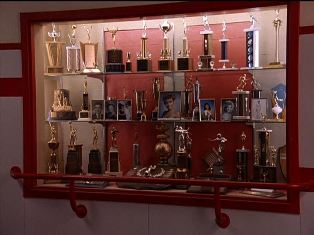 |
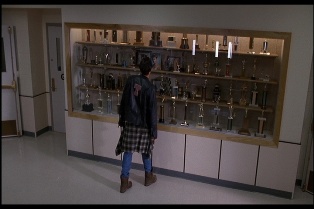 |
| Trophy case in TV series |
Trophy case in FWWM |
Laura tells James she's "...gone. Long gone, like a turkey
in the corn." The phrase "turkey in the corn" is used in a
number of American folk songs. It's an out-of-date phrase,
but Laura might know it because her father is such a fan of
singing and dancing. There is a song with the actual title
of "Long Gone Like a Turkey Through the Corn" about an
escaped black slave in the pre-Civil War United States.
James tells Laura she's not a turkey because a turkey "is
one of the dumbest birds around." Turkeys have a reputation
in America for being dumb, but it's more myth than fact.
When Bobby starts walking backwards and dancing in the
schoolyard after talking to Laura, notice that the other
students passing by also start dancing and moving awkwardly
as they walk. Is Bobby unconsciously projecting his feelings
to others around him? It seems to effect only the people
already outside; those exiting from the school building walk
normally.
When Donna asks Laura, "Do you think that if you were
falling in space that you would slow down after a while or
go faster and faster?" and Laura answers, "Faster and
faster," the whooping sound of the Man From Another Place is
heard.
The Palmer house exterior seen here is different than the
one seen in episodes of the TV series. The interior of the
house also appears different in many respects, including
Laura's room. The house number seen here is 708. In
Twin Peaks: An Access Guide to the Town, the
house appears to be on Frost Avenue, so the house would be
708 Frost Avenue.
The title page of Laura's diary is written slightly
differently here than that seen in the TV series. Obviously
a new prop was used.
At 46:32 on the Blu-ray, we see the bedpost tops on Laura's
bed that allegedly unscrew to allow her to hide small items
inside the posts (as mentioned by Maddy in
Episode 5:
"Cooper's Dreams").
At 47:23 on the Blu-ray, Laura's pack of cigarettes appears
to be Camel brand.
As Laura flips through her diary, a couple of pages are
somewhat legible but don't impart anything of much interest.
The phrases used don't seem to match up with any of the
entries in the published
Secret Diary
of Laura Palmer.
The car Laura drives in the movie is a 1956
Buick Roadmaster
Riviera.
Harold Smith's cabin looks quite a bit different here from
the one seen in the TV series.
When Laura tells Harold about BOB, she says "Fire walk
with me" at the end and her face turns ghostly white and her
lips, black. It's possible she briefly allowed BOB to
possess her by saying that phrase. As I speculated in the
study of
Episode 29:
"Beyond Life and Death",
the phrase "fire walk with me" may be symbolic of inviting
BOB inside oneself (if BOB or another spirit is represented
by fire)..."Fire, walk with me=BOB, walk with me."
Leland has the the same white face and black lips as he enters
Glastonbury Grove after having killed his daughter near the
end of the movie.
The make-up effects on her face here are similar, but not quite the
same as those seen on Windom Earle for a brief moment in
Episode 28:
"Miss Twin Peaks". |
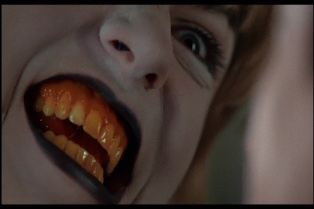 |
Laura asks Harold to hide her secret diary for her because
BOB doesn't know about him. But she is seen to have written
about Harold in the diary (in
The Secret
Diary of Laura Palmer), so it would actually
seem likely that BOB does know. Plus, if she was briefly
possessed by BOB in the scene discussed above when she said
"Fire walk with me", he may even have seen Harold through
her eyes at that moment.
At 50:50 on the Blu-ray, one of the books visible on the
shelf in Harold's cabin is Night Falls on the City,
a 1967 novel about life under Nazi rule in Vienna, Austria
by British author Sarah Gainham (1915-1999).
The interior of the RR Diner looks quite a bit different
than it does in the TV series. The production probably shot
inside the actual location of the Mar T Cafe (which served
as exterior shots of the RR) at the time.
Norma's hairstyle is much shorter here than it should be (as
seen in the TV series). If actress Peggy Lipton had changed
her hairstyle by the time of the movie, I wonder why the
production didn't just use a long wig on her?
The film suggests that it was normally Heidi who assisted
Laura with the Meals on Wheels deliveries. This might
explain why we see Heidi so infrequently at the RR on the TV series.
She might have inherited the logistics/delivery of the
Meals on Wheels program after the death of Laura.
Why does Heidi have a bloody nose here?
When Heidi is unable to assist Laura deliver Meals on Wheels
due to a bloody nose, Shelly seems reluctant to help when
Norma asks her. Possibly this is because Shelly is having an
affair with Laura's boyfriend, Bobby (as seen in the TV
series).
At 53:11 on the Blu-ray, you can just barely see Mrs.
Tremond and her grandson walking up the street in the
distance before Laura sees them about 25 seconds later.
At 56:59 on the Blu-ray, as Leland walks out of his house,
the neighbor's house is seen to have an orange delivery box
for the Everett, WA
Herald
newspaper.
At 57:09 on the Blu-ray, Leland's car appears to be the same
1975
Chevrolet
Caprice Classic convertible he drove in the TV series, but
the license plate is different! Here, it is 759-EAK. In the
series it was 710-YEP.
The car parked in front of Leland's on the street in front of
his house is a 1979
Fiat Brava Station Wagon.
At 58:49 on the Blu-ray, Leland examines Laura's "filthy
hands" and claims to spy dirt way under the fingernail of
the ring finger of her left hand. This is the hand under
which he will plant the letter R after he kills her several
days from now.
At 1:02:22 on the Blu-ray, notice that there is a tiny owl
engraved as part of the lamp next to Sarah in her and
Leland's bedroom.
Does anyone have any comment on the angel painting in
Laura's room? And why does the angel disappear from the
painting later on? Presumably, the missing angel is related
to Laura's comment earlier in the film about falling faster
and faster and finally bursting into flame "and the angels
wouldn't help you...because they've all gone away." It may
also relate to Laura later telling James, "Your Laura
disappeared."
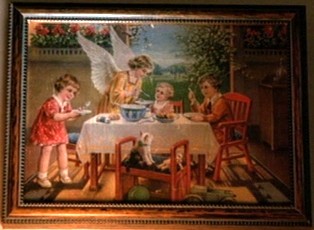
It is interesting to note that in the dream world, the dwarf
tells Cooper, "I am the arm," implying he is the arm that
Mike removed from Philip Gerard to rid himself of the
tattoo. And the script of the movie
refers to the dwarf as "the Man From Another Place (Mike)"
during Agent Jeffries' description of the meeting above the
convenience store! So, it would seem that the dwarf is Mike!
Also, the whooping sound the dwarf makes is heard when the
One-Armed Man approaches Leland and Laura on the highway
into town later in the film.
In Laura's dream, Cooper tells Laura not to take the ring.
The ring seems to be a symbol of death (in Laura's
case, and also brings death to several individuals in
The
Secret History of Twin Peaks), forcing BOB to kill her at the train car later, so it
seems as if Cooper is trying to change the past by getting
Laura to not accept the ring, preventing her death (and,
presumably, preventing his investigation of her murder, thus
preventing him from meeting Annie and, further, preventing
Annie from being taken to the Black Lodge by Windom Earle in
the TV series, thus saving her).
At 1:06:51 on the Blu-ray, Laura holds her left arm, as it
has gone numb, just as Irene described happened with Teresa
a year earlier.
When Annie appears in Laura's bed in her dream, notice that
she is wearing Caroline's dress, as seen in
Episode 29:
"Beyond Life and Death".
Annie also seems to be trying to either prevent Cooper from
entering the Black Lodge or saving him from it, by telling
Laura to write in her diary that the good Dale is in the
Lodge and he can't leave.
The motorcycle James rides appears to be the same one he
rode in the TV series, a 1978
Harley-Davidson FLH 80 Electra
Glide.
The Johnson's kitchen is less decorated here than it was in
the TV series.
Notice that the kitchen floor in the Johnson home looks
dirty as Leo shows Shelly how to properly scrub it. This
combined with the incomplete walls and torn wallpaper may
suggest that they have only recently purchased the house as a
fixer-upper.
Donna asks Laura, where are the cookies (Laura's parents),
and Laura responds, "You mean Fred and Ginger?" with Donna nodding
and
saying, "Dancing." "Fred and Ginger" is a reference to Fred
Astaire (1899-1987) and Ginger Rogers (1911-1995), actors
and dancers famously known for their romantic musical films
in the 1930s.
The Log Lady gives Laura a warning before she enters the
Roadhouse. According to
The Secret
Diary of Laura Palmer, Laura met the Log
Lady previously, and had a conversation with her, on
November 10, 1985.
The singer at the Roadhouse is Julee Cruise.
At 1:14:34 on the Blu-ray, a faded out sign for Leinenkugel
is seen in the Roadhouse as Laura enters. This is a
reference to
Leinenkugel
beer. At 1:16:34, a neon sign for
Rainier beer is seen.
These are rare references to a real beer in Twin
Peaks; other beer signs are generic versions made to
look similar to the branding of actual beers. Empty Rainier
beer bottles are seen scattered among hundreds of cigarette
butts on the floor of Partyland in a later scene.
In the Roadhouse, Buck slides a fifty dollar bill to Laura
and says he wants to go around the world, but she tells him,
"This ain't gonna get you to Walla-Walla."
Walla-Walla is a city in Washington.
The script refers to the night club Laura, Donna, Buck, and
Tommy go to in Canada as Partyland.
When Laura bumps into a stoned Ronette Pulaski at Partyland,
she says to Ronette, "I haven't seen you since I was thrown
out of One-Eyed Jacks," and Ronette slurs, "What else did we
do together?" and then, "I remember." Ronette may be
referring to a lesbian encounter which they are inferred to
have had together in
The Secret
Diary of Laura Palmer. The diary also
reveals that Laura was fired from One-Eyed Jacks after
humiliating Blackie (the house matron) in a sexual
encounter.
After Buck slips some kind of drug into Donna's beer, the
stoned Donna picks up Laura's discarded blouse and Tommy
ties it around her waist. Donna then starts acting
completely uninhibited, kissing Tommy passionately and
winding up with her own top off while he kisses her body.
Laura has to rescue her from the night of debauchery and
tells her never to wear her stuff. It seems as if Donna
absorbed some of Laura's unrestrained sexuality by the
wearing of her clothing. In a few episodes of the TV series,
Donna wears Laura's sunglasses and starts smoking and
behaving in an uncharacteristically forward manner with
James.
When Mike (the One-Armed Man) starts following Leland and
Laura into town, Laura asks her father if the engine's on
fire because she smells something burning. This must be the
"scorched engine oil" smell that accompanies a spirit
possession as reported by Dr. Jacoby in
Episode 8B:
"Answers in Dreams".
The One-Armed Man is driving a
Toyota Hilux pickup truck
with a Chinook camper over the bed.
During the encounter at the stop light, the One-Armed Man is
wearing the Owl Cave ring.
During the confrontation at the stop light, it's clear Mike
knows that Leland is BOB. So why doesn't he ever tell Cooper
that in the TV series?
The automobile service station Leland pulls his car into
after the encounter with the One-Armed Man is Mo's Motor.
Northwest Custom Cycle is seen next to it (a business in
Snoqualmie, WA).
The car with the hood up being worked on at Mo's Motor
is a 1959 Chevrolet Biscayne.
At 1:33:22 on the Blu-ray, we see that Teresa Banks also had
a personal ad in Flesh World, just as Laura and
Ronette did in the TV series.
In a flashback, Leland says that Teresa looks just like his
Laura, but she doesn't really.
Laura says that the One-Armed Man who harassed them at the
stop light looked familiar. In
Episode 13:
"Demons", Mike tells Cooper that BOB was
once his familiar, a supernatural entity, often seen in the
form of an animal, who assists a sorcerer or witch with the
practicing of magic.
A
Coca-Cola dispenser is seen at the motel at 1:34:59 on
the Blu-ray in Leland's memory of seeing Laura with Ronette
in Teresa's motel room.
The movie suggests that Teresa Banks was killed by Leland/BOB because
she was blackmailing him, having realized his identity as
Laura's father when he backed out of a hook-up with Teresa
and her two friends, Laura and Ronette.
Laura's decoy diary is not of the same design as the one
seen in
Episode 0B:
"Northwest
Passage". There is also nothing written in
it on the February 5 page, while there is in the
aforementioned TV episode. The entry on the February 6 page
has the 1989 date written "DAY ONE" written in it, but there
is also an entry for this date in 1988, a year earlier,
indicating she's had this "second diary" for at least that
long (unless she wrote it that way to throw any unauthorized
readers of the diary off the track that it was new to her).
At 1:38:12 on the Blu-ray, notice that the panning night
shot of smoke from the mill stack is flowing in reverse. Is
there a significance in this (like time flowing in reverse)?
Or is it just an editing anomaly because Lynch or the film
editor decided they wanted the pan to go from right-to-left
instead of the way it was shot, left-to-right?
The man who comes to meet Bobby and Laura in the woods for
the drug deal is Deputy Cliff Howard, seen as part of the
Deer Meadow Sheriff's Department during the Teresa Banks
murder investigation conducted by Agents Desmond and
Stanley. It seems that he knows Jacques.
Why does Cliff suddenly pull a gun on
Bobby and Laura? Bobby then pulls his gun and shoots him in
self-defense, killing him. It's never explained, but there
is a deleted scene that would have been later in the film
where Bobby discovers the next day that the bag of cocaine
that Cliff brought to sell them was just baby laxative. This
may indicate that Cliff intended to take their money and
leave them nothing, possibly also killing them first.
This scene explains the story behind who it was
that Bobby
killed, as James remarks Laura had told him (in
Episode 0B:
"Northwest
Passage"). This version of the
drug deal and who Bobby killed is very different from the
one presented in
The Secret
Diary of Laura Palmer.
Cliff has wavy dirty-blonde hair, but when Bobby takes his
third shot at him, hitting him in the back of the head, his
hair is gray! It's a fake head, rigged to explode from the
gunshot, but why the gray hair? Did the practical effects
department run out of wavy blonde wigs?
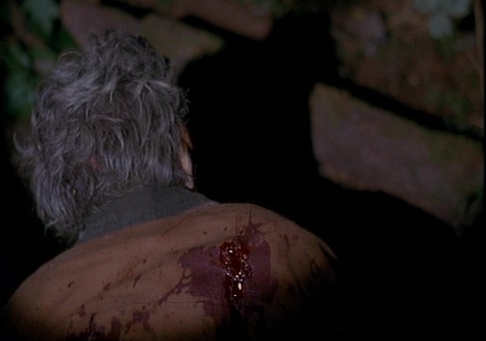
As Bobby starts trying to cover up Cliff's body with dirt to
hide it, the stoned Laura says, "Bobby, you killed Mike,"
referring to Bobby's high school buddy, Mike Nelson (the two
men do look somewhat similar). He shakes her, telling her to
shut up, it's not Mike. But then he turns back to the body
and looks at it with a somewhat perplexed expression and
says, "Is this Mike?" This may be another indication of an
empathic nature in Bobby, as he seems to be absorbing
Laura's stoned impression that the body is Mike.
At 1:47:14 on the Blu-ray, Leland turns on the ceiling fan
above the stairway and, hearing the sound of it whirring
from her bedroom, Laura looks startled and concerned. It may
be that Leland/BOB is in the habit of turning on that
ceiling fan before molesting her, accounting for why the fan
is something of a recurring image in the Palmer house in
early episodes of the TV series. Perhaps the whirring sound
and the fan's air currents somewhat diminish the sounds
coming from Laura's bedroom so that the drugged Sarah
doesn't know what exactly has been happening all these
years.
At 1:47:20 on the Blu-ray, Sarah has fallen asleep
(presumably from a drug in the milk Leland gave her earlier)
while reading How to Speak German by Malone. As far
as I can tell, this is a fictitious book.
Is there any
particular reason Sarah would want to learn to speak German?
A deleted scene from the film has Leland asking his wife and
daughter to learn a Norwegian phrase because of the coming visit
of Norwegian investors for Ben Horne's Ghostwood Estates
project, but nothing about German.
Sarah partially awakens, groggily, seeing a white horse
materialize in her bedroom. She also sees a white horse
later just before Maddy's murder in
Episode
14:
"Lonely Souls".
In the Bible's Book of Revelation, the
Fourth Horseman of the Apocalypse, Death, is said to ride a
pale horse; her husband, Leland, is death, to her daughter
Laura and, later, her niece Maddy. Possibly, the horse is
also representative of her own role in the deaths of her
daughter and niece, as she seemingly refuses to consciously
acknowledge what has been happening for years with her
husband.
At 1:49:31 on the Blu-ray, a pillow is visible between
Laura's legs, acting as a buffer between actors Sheryl Lee
and Frank Silva during the terrifying rape scene in her bed.
At 1:51:51 on the Blu-ray, the clock seen on the wall in
Laura's classroom is a Standard brand.
At 1:53:33 on the Blu-ray, a miniature
Jack Daniel's bottle
is seen on Laura's bed. She drinks it after snorting the
cocaine.
At 1:53:47 on the Blu-ray, Laura receives a phone call from
James. This must be the call her mother reports hearing when
she is questioned about her daughter's whereabouts by
Sheriff Truman the next day in
Episode 0A:
"Wrapped in
Plastic". However, in
Episode 16:
"Arbitrary Law",
Truman and Cooper discover that the call to Laura was placed
from Ben Horne's office...we never see that call here.
During her meeting with James in the night, Laura looks
behind him and suddenly screams loudly. What did she see?
The tears that were under Laura's eyelids suddenly disappear
at 1:57:46 on the Blu-ray.
At 1:59:28 on the Blu-ray, the license plate of James'
motorcycle is seen to be 7481D2, with expiration tags of
November 1989.
Jacques' cabin in the woods is different from the one seen in
Episode 5:
"Cooper's Dreams".
As Jacques exits the cabin to relieve himself, Leland
clobbers and kicks him, then hits him over the head with a
bottle. This is the incident that Jacques thought, in his
drunken state, was a fight with Leo as described in
Episode 7:
"The Last Evening".
The angel that appears to Ronette in the train car does
something to sever the rope that binds her arms behind her
back, but the ends of the rope are still tied around her
wrists. The angel must have also freed Laura's arms, as she
is able to pick up the ring tossed into the car by the
One-Armed Man and put it on her finger, but we also see that
there is no rope around her wrists, just the scars of where
the bindings chafed her skin.
How was Ronette able to have a flashback of BOB killing
Laura
Episode 8B:
"Answers in Dreams" when it is shown
here that Leland/BOB shoved her out of the train car before
Laura was killed?
During the murder of Laura scene here, BOB is depicted
wearing a full denim jacket (as seen in most of his other
appearances). But in the same murder scene as presented in
Episode 8B:
"Answers in Dreams", he is wearing a
denim jacket with the sleeves cut off.
The murder scene shows mostly Leland in the role of killer,
whereas the same scene in
Episode 8B:
"Answers in Dreams" shows only BOB
doing the killing.
The music that plays during Laura's death is Requiem No. 2 -
Agnus Dei, by Italian composer Luigi Cherubini (1760-1842).
At 2:05:42 on the Blu-ray, Leland has a large blood stain on
his shirt, underneath his coat. It doesn't seem it could be
Laura's blood or it would be splattered on the coat as well.
Is it Leland's own blood? Did he wound himself? Did BOB
wound him? BOB takes the blood away from him in the Waiting
Room shortly after.
At 2:07:34 on the Blu-ray, the Dwarf (the Man from Another
Place) touches the One-Armed Man on his left shoulder, where
his arm is missing, indicating, as the Dwarf told Cooper
earlier, that he is the arm. The Dwarf and the One-Armed Man
then speak the same words simultaneously, indicating they
are the same person speaking. He/they want their garmonbozia
(pain and suffering), presumably wanting back what was
stolen from them above the convenience store by BOB.
At 2:08:35 on the Blu-ray, the monkey whispers, "Judy." It's
hard to hear, turn your speakers up for this one.
At 2:08:41 on the Blu-ray, the hand moving the plastic away
from Laura's corpse is Sheriff Truman's from
Episode 0A:
"Wrapped in
Plastic".
As the film ends, Laura is in the Waiting Room and sees the angel;
she begins to smile and nod, as if it were speaking her, but
we don't hear anything besides music. Agent Cooper, standing
next to her with his hand on her shoulder, has a slight
smile on his face, as if happy for her. Then, what seem to
be tears of joy stream down Laura's face, she begins to
laugh (silently), even outright chortling as if she's just
been let in on the greatest joke ever. Maybe she has.
This moment also seems to be touched on in
"Palmer
Family Interview".
Unanswered Questions
At Hap's Diner, Irene mentions that Teresa Banks' left arm
(on which she wore the Owl Cave ring on her ring finger)
went numb for three days shortly before her death. What is
the significance of this?
How did Teresa get the ring?
Why does Agent Desmond vanish after reaching for the ring?
Why doesn't Ronette tell Cooper or the sheriff's department
what she knows about Teresa Banks, Leo, Jacques, and
BOB/Leland after she comes out of her coma during the events
of the TV series?
Who is Judy? In
Episode 28:
"Miss Twin Peaks",
a drugged Major Briggs confuses his own first name, Garland,
with Judy Garland (1922-1969), an American actress and
singer, best known for her portrayal of Dorothy Gale in the
1939 film adaptation of The Wizard of Oz; David
Lynch is known to be a fan of the film. But might Briggs'
remark about Judy Garland mean he knows who the mysterious
Judy mentioned here is? In that scene in the TV episode, he
seems to try to tell Cooper some things, but in his drugged
state they come out as odd phrases like "The King of Romania
was unable to attend," possibly his attempt to tell Cooper
that he (Cooper) is the "king" in Windom Earle's plot for
revenge, having seen the king playing card with Cooper's
face pasted on it pinned to the wall of Earle's cabin; and
he later says, "Protect the queen," referring to the queen
playing cards he saw representing the winner of the Miss
Twin Peaks contest, whom Earle intended to kill.
According to the article
"Between Two Worlds: Josie's Fate" at the
Twin Peaks Archive, an early draft of the film's script
mentioned Judy's sister, which co-writer Robert Engles said
would have been revealed to be Josie Packard if sequel films
had been made! It is interesting to note that, in the
Missing Pieces deleted scenes from the film, Jefferies
tells Gordon, Albert, and Cooper that he was "in Seattle at
Judy's" and we know that Josie was frequently visiting
Seattle during the course of the TV series; maybe she was
visiting her sister? Or maybe Josie was masquerading as this
Judy person?
What happened to Deputy Cliff's Howard's body, left out in
the woods after Bobby shoots him? There is no mention in the
movie or the TV series of such a body being found.
Why does Leland/BOB leave Ronette alive?
Has the "demon" called Mike really turned to the good side
as suggested in the TV series? Or is that just a front he
presents to Cooper, actually wanting to regain the
garmonbozia (pain and suffering) stolen from him by BOB, as
suggested in this film?
Memorable Dialog
no.wav
get me Agent Chester Desmond.wav
Oregon.wav
he's got his own M.O.wav
I can't tell you about that.wav
you can start that fresh pot of coffee.wav
27,000 dollars.wav
Irene is her name and it is night.wav
are you talking about that little girl that got
murdered?.wav
I know shit from shinola.wav
more popular than uncle's day in a whorehouse.wav
Good Morning America.wav
Indian whooping sound.wav
I've already gone places.wav
meet the long lost Phillip Jeffries.wav
I'm not gonna talk about Judy.wav
suffered some bumps on the ol' noggin.wav
garmonbozia.wav
we live inside a dream.wav
electricity.wav
I was having a bad dream.wav
God damn, these people are confusing.wav
this case gives me a strange feeling.wav
one of Cole's Blue Rose cases.wav
that really narrows it down.wav
how do you know what she likes?.wav
I
am the arm.wav
don't take the ring.wav
my name is Annie.wav
if I had a nickel.wav
I am as blank as a fart.wav
the party twins.wav
life is full of mysteries.wav
even Donna doesn't know me.wav
your Laura disappeared.wav
Back to Twin Peaks
Episode Studies